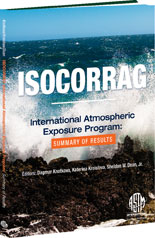
Corrosion Data
ISOCORRAG Collects and Discusses Data from a Global Corrosion Program
What effects do wind and water, sulfur and salt, have on metals? That's a multimillion dollar question for engineers and architects around the world designing with and specifying these materials for construction.
A new ASTM International book, ISOCORRAG, International Atmospheric Exposure Program: Summary of Results, addresses that question. The work collects years of atmospheric corrosion data about four metals - aluminum, copper, steel and zinc - in all regions of the world. "In addition, it includes climate information with these corrosion results and a set of correlations that can provide a way to predict atmospheric corrosion rates from weather information in any region of the globe," says Sheldon Dean Jr., Dean Corrosion Technology Inc., Glen Mills, Pa., and co-editor of the work.
That's a great deal of information useful to engineers and architects who select construction materials for outdoor applications. That's information useful to scientists who are studying the behavior of metals in marine environments, understanding the kinetics of atmospheric corrosion and investigating the effects of sulfur dioxide pollution. And, that's information useful to preserving historically significant structures.
"Although the book is not very long (74 pages), it has a wealth of information that would be hard to duplicate," Dean says. Based on an eight-year test program, the work provides comprehensive results from 13 different countries and 53 exposure sites covering industrial, urban, rural, marine and coastal locations in temperate, tropical and arctic zones. The book, like the test program, also incorporates weather and pollution data.
Editors Dagmar Knotkova, Katerina Kreislova and Dean systematically cover the corrosion information in five succinct and comprehensive chapters:
- Introduction,
- Experimental,
- Results,
- Analysis of Results and Summary, and
- Application of Results.
The exposure tests represent the first global atmospheric program undertaken that consisted of uniform testing with well-characterized samples to eliminate testing variations seen in many previous studies. The study included both wires and flat panels (the wires had higher corrosion rates than the panels).
The program was launched to determine the accuracy of two standards, ISO 9223, Corrosion of Metals and Alloys, Corrosivity of Atmospheres, Classification; and ISO 9224, Corrosion of Metals and Alloys, Corrosivity of Atmospheres, Guiding Values for the Corrosivity Categories, from International Organization for Standardization (ISO) Technical Committee 156 on Corrosion of Metals and Alloys. These two standards provide the methods to estimate atmospheric corrosion of metals in structures. The corrosion program data was used to revise these two standards as well as two related ISO corrosion standards and the classification system incorporating the standards.
The book also compares these results with those from the MICAT (Ibero-American Map of Atmospheric Corrosiveness) program, a large study of atmospheric corrosion primarily in tropical environments.
With ISOCORRAG, engineers, scientists and others who need to predict the corrosion damage to metals in outdoor applications can do so.
 SN Home
SN Home Archive
Archive Advertisers
Advertisers Masthead
Masthead RateCard
RateCard Subscribe
Subscribe Email Editor
Email Editor